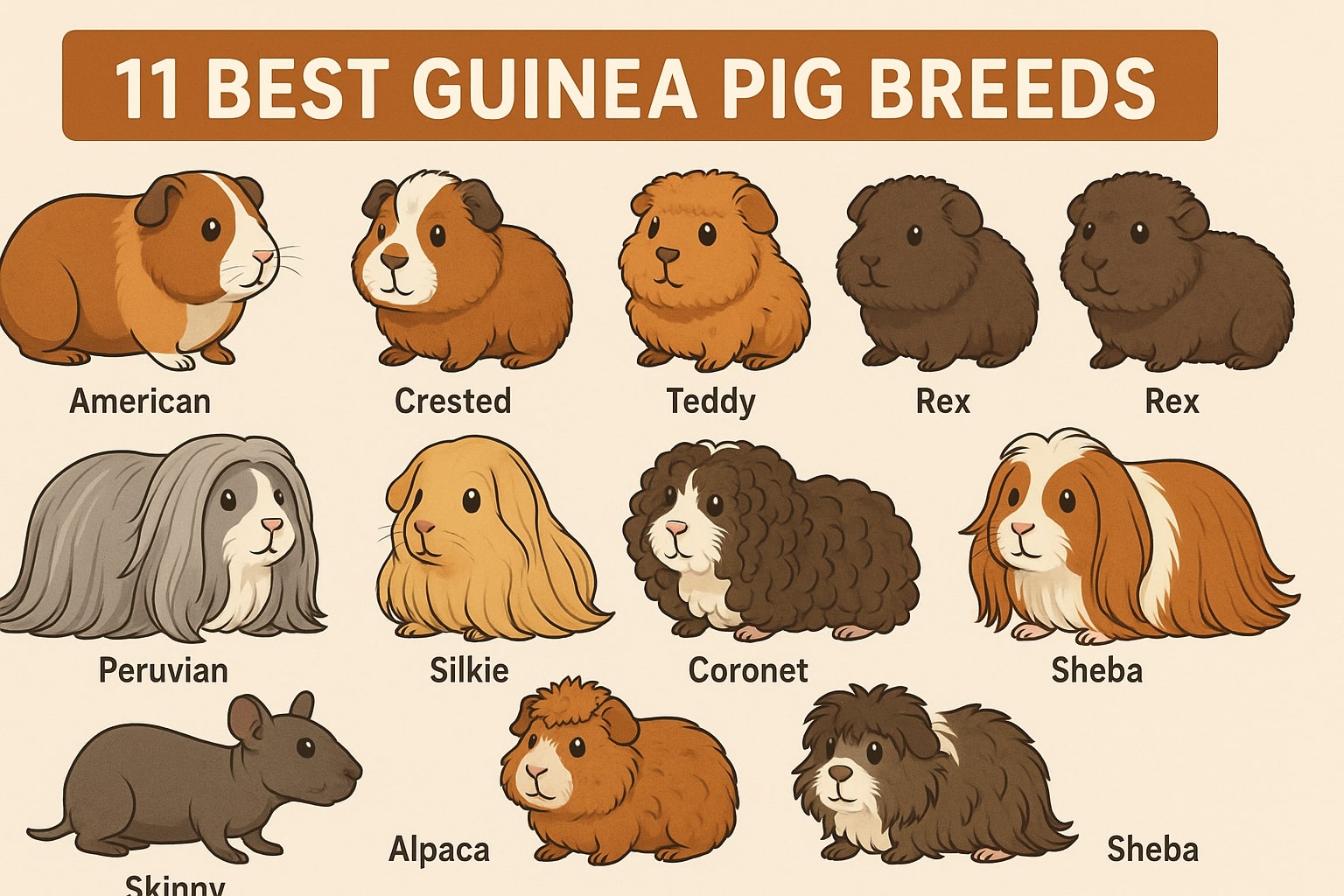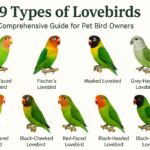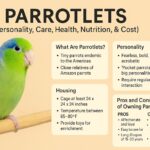Guinea pigs, scientifically known as Cavia porcellus, represent one of the most beloved small pets in the world today. These charming creatures have been domesticated since around 5000 BCE, leading to the development of a remarkable variety of breeds that showcase an incredible range of physical characteristics, temperaments, and care requirements.
From the classic American short-haired variety to the luxurious long-coated Peruvian breed, guinea pigs offer something for every pet enthusiast. A guinea pig is a great pet to own, but you should know about the different breeds to find the breed that suits your lifestyle, experience, and aesthetics.
The Rich History of Guinea Pig Breeding
The story of guinea pig breeding spans thousands of years, beginning with indigenous South American communities who first domesticated these animals in the Andes mountains. The period from 1200 to 1532 CE, which coincides with the Spanish conquest of the Incan Empire, saw indigenous South Americans selectively breeding guinea pigs primarily as agricultural stock for food and ritual purposes.
These early breeding efforts resulted in numerous landrace varieties that would later become the foundation for many of the formal modern breeds we recognize today.
When guinea pigs were exported to Europe in the 15th century, the breeding focus shifted dramatically from utility to companionship5. European breeders began developing guinea pigs as appealing pets rather than livestock, leading to the establishment of various competitive breeding organizations.
Today, several major organizations govern guinea pig breeding standards worldwide, including the American Cavy Breeders Association in the United States and Canada, the British Cavy Council in the United Kingdom, and the Australian National Cavy Council and New Zealand Cavy Council in their respective regions.
Each organization publishes its own standard of perfection and determines which breeds are eligible for showing, though it’s worth noting that the exact number of recognized guinea pig breeds varies depending on the governing body.
Some breeds recognized by the general public may not be officially acknowledged by breeding associations, while organizations may classify what others consider separate breeds as variations of a single breed.
Short-Haired Guinea Pig Breeds
Short-haired guinea pig breeds represent some of the most popular and accessible options for both novice and experienced guinea pig owners. These breeds typically require less grooming maintenance while still offering distinct personalities and appearances.
1. American Guinea Pig
The American Guinea Pig stands as the most recognizable and widespread breed, often serving as the archetypal image people conjure when thinking of guinea pigs. Native to the Peruvian Andes, these guinea pigs typically measure 8-9 inches in height and have an average lifespan of about seven years. Their short, smooth coat comes in an impressive array of colors and color combinations, making each individual unique in appearance.
American Guinea Pigs are renowned for their friendly and sociable nature, though proper socialization based on trust is essential to nurture their naturally pleasant personalities1. Their active temperament and gentle disposition make them excellent choices for families and first-time guinea pig owners. The maintenance requirements for their coat are minimal compared to long-haired varieties, requiring only basic brushing and occasional baths.
2. Crested Guinea Pig
Crested Guinea Pigs offer a delightful variation on the American breed, featuring all the same characteristics with one distinctive addition: a prominent “cow lick” or crest on the top of their head. This crown-like rosette of hair gives them their name and creates an instantly recognizable appearance that many find endearing.
The American Crested variety specifically features a single white crest on the forehead paired with a smooth, solid-colored body. These guinea pigs maintain the same gentle and affectionate temperament as their American counterparts, making them ideal for beginner pet owners. Their grooming requirements remain minimal, with the crest requiring only occasional attention to keep it looking neat.
3. Teddy Guinea Pig
Teddy Guinea Pigs earn their name from their distinctive coat texture, which resembles that of a plush teddy bear. Their short, dense, and fuzzy coat stands upright, creating a tousled appearance that adds to their cuddly charm. The unique texture of their fur gives them a springy feel that distinguishes them from other short-haired breeds.
These guinea pigs feature broad, rounded faces with slightly upturned noses, enhancing their cute and cuddly appearance. One practical advantage of Teddy Guinea Pigs is their reduced shedding compared to other breeds, making them ideal for households concerned about pet hair. Their playful personality and low-maintenance grooming needs make them excellent choices for families and first-time owners.
4. Rex Guinea Pig
Rex Guinea Pigs are easily recognized by their distinctive short, woolly coat that provides a unique texture unlike any other breed. Their soft, dense fur creates an almost velvet-like feel that many owners find particularly appealing. The Rex coat pattern can appear in various colors and combinations, offering plenty of visual variety within the breed.
These guinea pigs share the friendly temperament common to most short-haired breeds while requiring slightly more attention to their unique coat texture. Regular gentle brushing helps maintain the characteristic woolly appearance and prevents matting, though their grooming needs remain manageable for most owners.
Long-Haired Guinea Pig Breeds
Long-haired guinea pig breeds represent the more dramatic and visually striking end of the guinea pig spectrum. While these breeds require significantly more grooming commitment, they offer unparalleled beauty and elegance that many enthusiasts find irresistible.
1. Peruvian Guinea Pig
The Peruvian Guinea Pig arguably stands as the most striking of all guinea pig breeds, featuring long, flowing locks that spill dramatically over their forehead and cascade from the spine of their back.
Their hair can grow to impressive lengths, sometimes reaching the ground if left uncut. This magnificent coat requires daily grooming and regular trimming to prevent matting and maintain the guinea pig’s health and comfort.
Peruvian Guinea Pigs often participate in shows where their coat length and quality are primary judging criteria. However, pet owners typically keep their Peruvian guinea pigs in “pet cuts” with shorter hair for easier maintenance.
Despite their high-maintenance appearance, these guinea pigs possess the same gentle temperament as other breeds, though their grooming needs make them better suited for experienced owners.
2. Silkie Guinea Pig
Also known as Shelties, Silkie Guinea Pigs feature long, straight hair that grows backward from their head, creating a smooth, flowing appearance. Unlike Peruvian guinea pigs, Silkies don’t have hair falling over their faces, making it easier to see their expressions and for them to navigate their environment. Their coat should appear whole and unparted, giving them a distinctive teardrop shape when viewed from above.
The silky texture of their hair gives this breed its name and creates a particularly luxurious feel. Regular grooming is essential to prevent tangles and mats, but many owners find the grooming process enjoyable and relaxing. Silkie Guinea Pigs maintain gentle, affectionate personalities that make the extra grooming effort worthwhile for many enthusiasts.
3. Texel Guinea Pig
Texel Guinea Pigs combine the length of long-haired breeds with a unique curly texture that creates distinctive ringlets throughout their coat. Their long, soft hair appears in spiral curls that give them an almost sheep-like appearance. Their heads are generally wider and more rounded than other breeds, adding to their distinctive look.
The curly nature of their coat requires specialized grooming techniques to maintain the ringlet pattern while preventing matting. Many owners find that gentle finger-combing works better than traditional brushes for maintaining the characteristic curl pattern. Despite their unique grooming needs, Texel Guinea Pigs possess friendly, social personalities that make them rewarding companions.
4. Coronet Guinea Pig
The Coronet Guinea Pig represents a fascinating combination of two distinct breed characteristics: the long, straight hair of a Silkie paired with the rosetted crown of a Crested guinea pig. This unique combination creates a guinea pig with flowing hair and a distinctive crest on top of their head, offering the best of both breed types.
Coronet Guinea Pigs require the same level of grooming commitment as other long-haired breeds, with additional attention needed for their distinctive crest. The combination of features makes them particularly popular in show circles, though they also make lovely pets for those willing to commit to their grooming needs.
Special and Rare Guinea Pig Breeds
Several guinea pig breeds stand out for their unusual characteristics or rarity, offering unique options for experienced owners seeking something truly distinctive.
1. Skinny Guinea Pig
Skinny Guinea Pigs represent one of the most unusual breeds, characterized by their nearly hairless bodies. These guinea pigs have hair only on their faces, feet, and sometimes shoulders, with the rest of their body remaining bare. Despite their unusual appearance, Skinny Guinea Pigs possess the same friendly temperament as their furry counterparts.
The lack of fur creates special care considerations, as Skinny Guinea Pigs are more sensitive to temperature extremes and require protection from both cold and direct sunlight. Their exposed skin also needs regular moisturizing to prevent dryness and irritation.
2. Alpaca Guinea Pig
The Alpaca Guinea Pig ranks among the rarest breeds, featuring a luxurious, curly coat that makes it highly sought after for show purposes. Also known as Boucle, Merino Peruvian, or Curly Coated Coronet, these guinea pigs have curly fur with a distinctive forelock resembling a Merino sheep. Their unique appearance and rarity make them particularly valuable in breeding and show circles.
Alpaca Guinea Pigs require specialized grooming to maintain their curly coat, with careful attention needed to prevent over-bathing, which can lead to dry skin. Their rarity means finding reputable breeders can be challenging, making them a breed primarily for serious enthusiasts.
3. Sheba Guinea Pig
The Sheba Guinea Pig represents a unique Australian breed developed in New South Wales during the 1970s. Also known as Sheba Mini Yaks, these guinea pigs feature long, tousled coats that always appear somewhat wild and unkempt, adding to their distinctive charm. They’re recognized for their rosettes and mutton chop whiskers that contribute to their unique appearance.
The perpetually tousled look of Sheba Guinea Pigs means that achieving a “perfect” groomed appearance is neither expected nor desired. This makes them somewhat easier to maintain than other long-haired breeds while still offering the appeal of flowing locks.
Conclusion
The world of guinea pig breeds offers remarkable diversity, from the classic American short-haired varieties perfect for beginners to the exotic long-haired breeds that serve as living works of art. Each breed brings its own unique characteristics, care requirements, and personality traits that can match different owner preferences and experience levels.
You can find guinea pigs to match your lifestyle and preferences, from the low-maintenance Teddy to the graceful Peruvian to the rare Alpaca.
These breed differences are important to ensure long, happy relationships between pet owners and their companion guinea pigs.
- Parrotlets (Personality, Care, Health, Nutrition, & Cost) - June 20, 2025
- Caique (Personality, Care, Health, & Nutrition) - June 20, 2025
- The Complete Guide to Golden Retrievers - June 9, 2025















